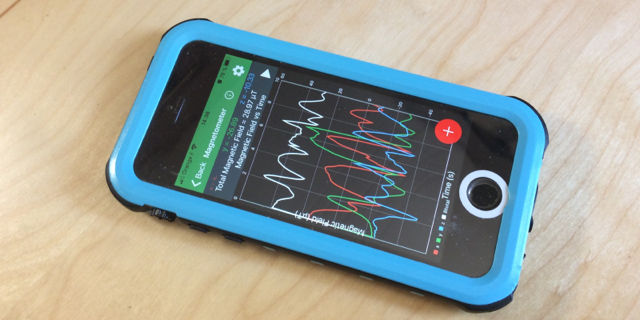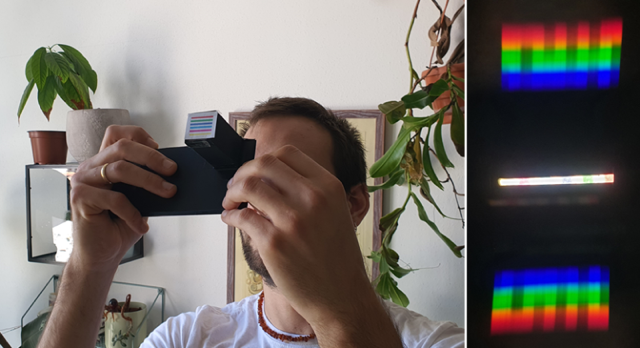Smartphone Physics on the Rise
The shuttering of schools and universities around the globe has left educators scrambling to take their normal in-person classes online. Virtual lectures quickly replaced chalk-board talks. But creating remote laboratory classes proved trickier as the school’s oscilloscopes, light meters, and barometers remain behind locked doors. Some teachers decided to scrap the measurement-taking aspect of labs, asking students to analyze existing datasets instead. Many educators, however, have turned to smartphones and tablets—devices found in most homes—whose sensors can measure everything from a magnetic force to atmospheric pressure. As a consequence, the developers of apps that interface with the sensors report a significant increase in the number of downloads of their software over recent weeks.
“You cannot take home a whole physics laboratory, but most people have a smartphone,” says Juan Carlos Castro Palacio, a nuclear physicist from Spain, who studies the use of smartphones as educational tools for physics. With a phone, you can conduct experiments on most of the topics of a general physics lab, he says.
One popular physics app is Physics Toolbox, a program that allows users to record measurements taken using a phone’s sensors. According to its creators, husband and wife duo Chrystian and Rebecca Vieyra, downloads of the app were up 25% in the month of March. Normally, the number of new users is consistent throughout the school year, “so this is more than just a blip,” Rebecca says. She added that a company near Paris contacted the couple last month about putting the app on tablets being sent home with local school children. Another app, Phyphox, saw a download uptick of 30% in the second half of March. “I’ve had several emails from teachers emphasizing how helpful Phyphox is in the current situation,” says Sebastian Staacks, at the University of Aachen in Germany, who created Phyphox.
So what experiments do educators have their students carrying out while everyone is stuck at home? In Uruguay, Arturo Marti, a physicist at the University of the Republic, has his students measuring magnetic fields with their smartphone’s magnetometer. This sensor typically tells apps like Google Maps which way is north, but it can measure magnetic fields other than Earth’s. Marti’s students are using the sensor to measure a magnet’s magnetic field at different distances from the phone. They then plot that data on a graph, which they can use to find the magnet’s moment.
Besides a magnetometer, most smartphones also have a barometer that measures air pressure, an inclinometer that detects the angle of the phone, a light meter that checks the intensity of ambient light, and a microphone that can analyze the frequencies in incoming sounds. Some phones even have thermometers and hygrometers that measure air temperature and humidity, respectively. “You can really do a lot of different experiments,” says Tommaso Rosi at the University of Trento in Italy.
Rosi has his students—mostly mathematicians studying to be physics teachers—turning their phones into spectroscopes. Armed with a carboard tube, a diffraction grating, and the smartphone’s camera, the students are studying fluorescence and color mixing. For the latter, the students use their homemade spectroscopes to take a photo of the light passing through a colored piece of paper. The image looks like a line spectrum with different color bands showing up for the various hues of ink. Students who don’t have access to a diffraction grating can make one with an old CD or DVD. “They are really low-cost experiments,” Rosi says.
Their low cost and ease of implementation is what has attracted many physicists to devise smartphone experiments. Sameer Arabasi, an optical physicist at the German Jordanian University in Jordan, has previously integrated smartphone assignments into his courses. For example, he had students use a smartphone’s magnetometer and a compass app to measure the magnetic dip angle of Earth’s magnetic field—that is the angle made with the horizontal by the field lines. Arabasi was motivated by a desire to simplify experiments and reduce the need for the detailed instruction manuals that usually accompany a lab apparatus. He says that his students can lose interest when they spend half of the class time reading the steps for traditional lab assignments. “We have to make physics more engaging and smartphone physics offers a way to do that.”
Taking labs out of university basements and into the field doesn’t have to stop when lockdowns lift. “[Physics] is something you can study anywhere, anytime,” says Ann-Marie Mårtensson-Pendrill, at Lund University in Sweden, who works in physics education. One of her favorite venues for an impromptu physics experiment is a roller coaster. In the past, she has taken first year undergraduates to an amusement park to study the laws of motion while they twist on a carousel or swing on a pendulum ride. Students use their phone’s barometer, accelerometer, and gyroscope to measure elevation, g force, and angular velocity, allowing them to map out the forces and energy at different points on a roller coaster loop, for example. These assignments will have to wait until the lockdowns lift, but she says they are great activities for letting students feel physics in action, while also having fun.
–Katherine Wright
Katherine Wright is a Senior Editor for Physics.





